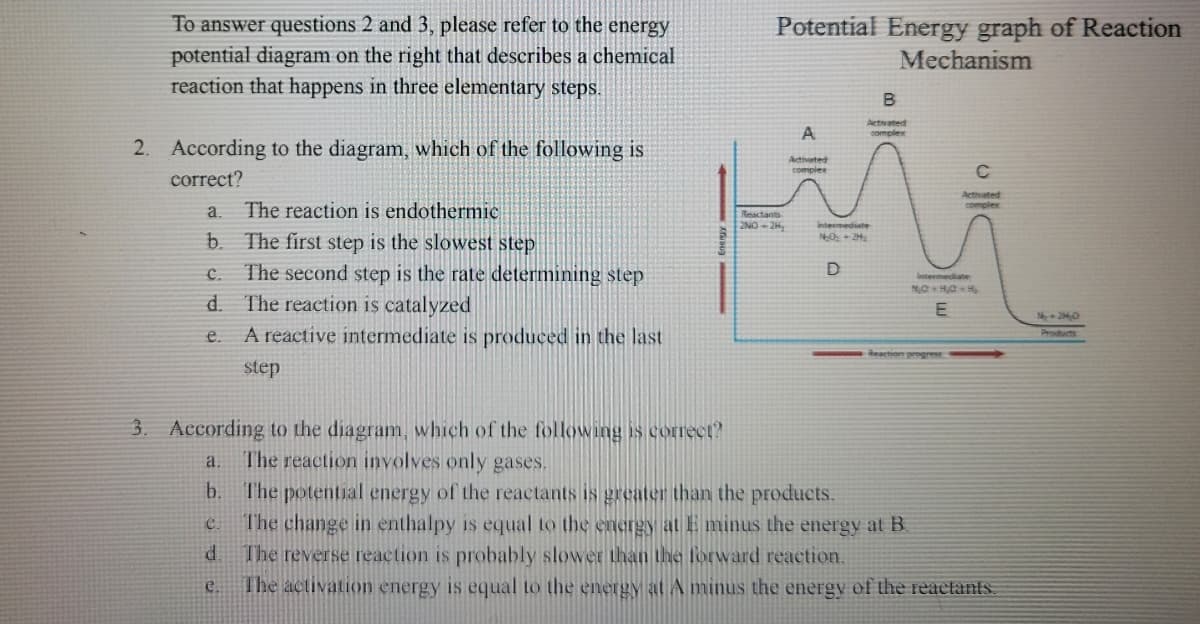Activated complex 2. According to the diagram, which of the following is Activeted complex correct? Activated complex a. The reaction is endothermic 2NO-2H Intermediate b. The first step is the slowest step The second step is the rate determining step The reaction is catalyzed A reactive intermediate is produced in the last NO + 2H C. Intermediate d. e. Products Reaction progress step 3. According to the diagram, which of the following is correct? The reaction involves only gases. a. The potential energy of the reactants is greater than the products. The change in enthalpy is equal to the energy at E minus the energy at B. d. b. C. The reverse reaction is probably slower than the lorward reaction, The activation energy is equal to the energy at A minus the energy of the reactants. e.
Activated complex 2. According to the diagram, which of the following is Activeted complex correct? Activated complex a. The reaction is endothermic 2NO-2H Intermediate b. The first step is the slowest step The second step is the rate determining step The reaction is catalyzed A reactive intermediate is produced in the last NO + 2H C. Intermediate d. e. Products Reaction progress step 3. According to the diagram, which of the following is correct? The reaction involves only gases. a. The potential energy of the reactants is greater than the products. The change in enthalpy is equal to the energy at E minus the energy at B. d. b. C. The reverse reaction is probably slower than the lorward reaction, The activation energy is equal to the energy at A minus the energy of the reactants. e.
Chapter12: Chemical Kinetics
Section: Chapter Questions
Problem 9RQ
Related questions
Question
Both are multiple choice only

Transcribed Image Text:To answer questions 2 and 3, please refer to the energy
potential diagram on the right that describes a chemical
reaction that happens in three elementary steps.
Potential Energy graph of Reaction
Mechanism
A.
Activated
complex
2. According to the diagram, which of the following is
Ativeted
complex
correct?
Activated
complex
a.
The reaction is endothermic
Reactants
intermediate
b. The first step is the slowest step
The second step is the rate determining step
The reaction is catalyzed
NO+ 2H
C.
intermediate
d.
N+ 20
A reactive intermediate is produced in the last
Products
e.
step
3. According to the diagram, which of the following is correct?
The reaction involves only gases.
a.
b.
The potential energy of the reactants is greater than the products.
The change in enthalpy is equal to the energy at E minus the energy at B.
The reverse reaction is probably slower than the forward reaction.
The activation energy is equal to the energyat A minus the energy of the feactants.
C.
d.
Expert Solution
This question has been solved!
Explore an expertly crafted, step-by-step solution for a thorough understanding of key concepts.
This is a popular solution!
Trending now
This is a popular solution!
Step by step
Solved in 2 steps

Knowledge Booster
Learn more about
Need a deep-dive on the concept behind this application? Look no further. Learn more about this topic, chemistry and related others by exploring similar questions and additional content below.Recommended textbooks for you


Chemistry: An Atoms First Approach
Chemistry
ISBN:
9781305079243
Author:
Steven S. Zumdahl, Susan A. Zumdahl
Publisher:
Cengage Learning

Chemistry
Chemistry
ISBN:
9781305957404
Author:
Steven S. Zumdahl, Susan A. Zumdahl, Donald J. DeCoste
Publisher:
Cengage Learning


Chemistry: An Atoms First Approach
Chemistry
ISBN:
9781305079243
Author:
Steven S. Zumdahl, Susan A. Zumdahl
Publisher:
Cengage Learning

Chemistry
Chemistry
ISBN:
9781305957404
Author:
Steven S. Zumdahl, Susan A. Zumdahl, Donald J. DeCoste
Publisher:
Cengage Learning

Introductory Chemistry: A Foundation
Chemistry
ISBN:
9781337399425
Author:
Steven S. Zumdahl, Donald J. DeCoste
Publisher:
Cengage Learning

Introductory Chemistry: An Active Learning Approa…
Chemistry
ISBN:
9781305079250
Author:
Mark S. Cracolice, Ed Peters
Publisher:
Cengage Learning

Chemistry for Today: General, Organic, and Bioche…
Chemistry
ISBN:
9781305960060
Author:
Spencer L. Seager, Michael R. Slabaugh, Maren S. Hansen
Publisher:
Cengage Learning